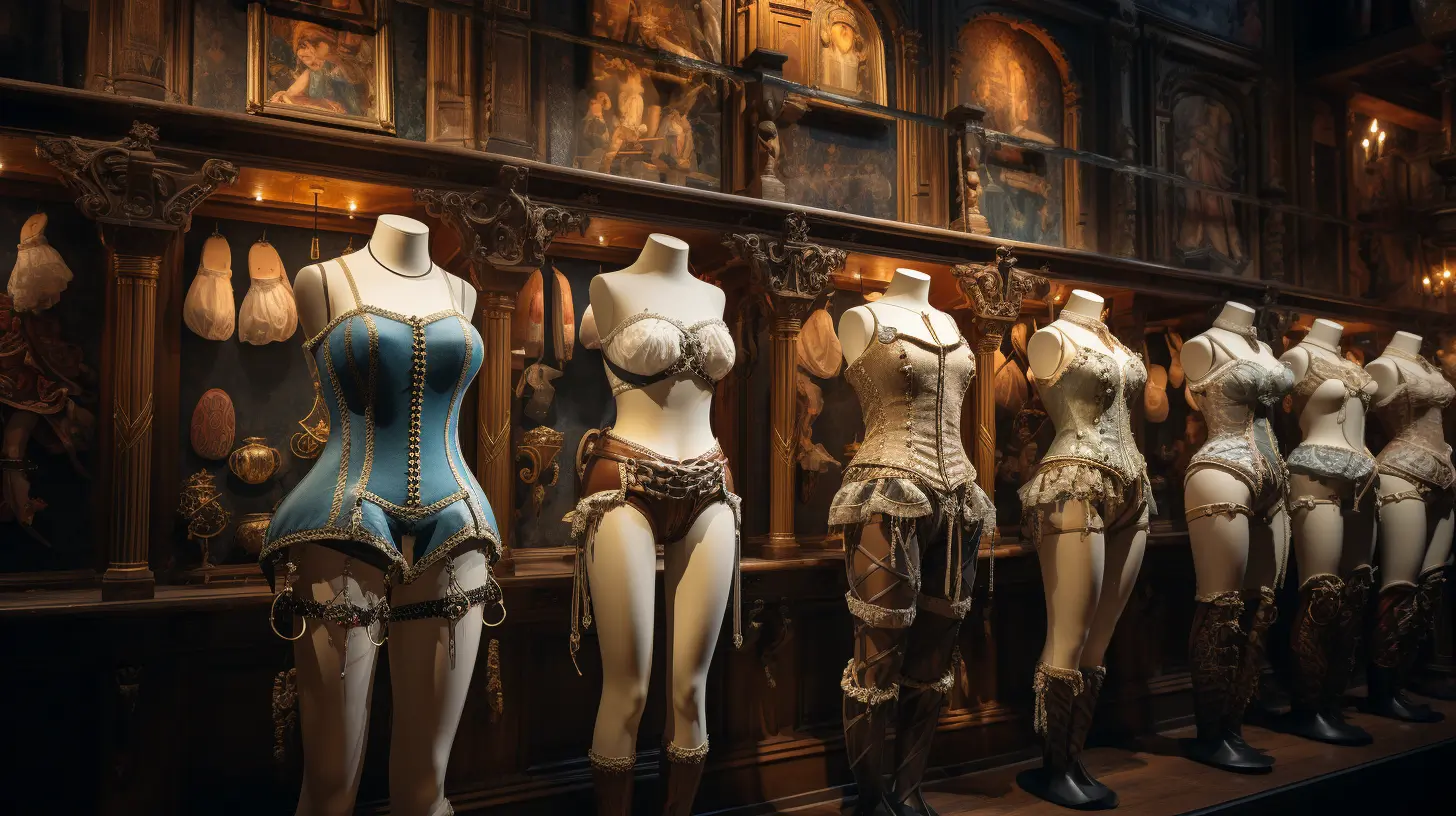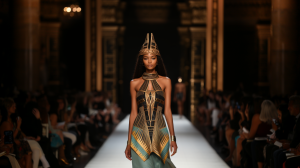
Mesopotamian Marvels Unveiled
Welcome to FashionTimeWarp’s mesmerizing journey through the annals of history! 🕰️ Today, we embark on an enthralling exploration into one of the world’s earliest civilizations, the cradle of human society – Mesopotamia. In this digital time machine, we’ll uncover the artistic intricacies of Mesopotamian fashion, a tapestry woven with threads of culture, symbolism, and creativity.
A Glimpse into the Past
Imagine a world where the fertile crescent between the Tigris and Euphrates rivers gave birth to a civilization that would forever shape our understanding of human history. Mesopotamia, often referred to as the “Cradle of Civilization,” was not only a crucible of innovation but also a canvas for self-expression through clothing and adornment.
In the pages that follow, we will delve deep into the heart of this ancient culture, where clothing and accessories were more than just garments; they were statements of identity, status, and artistry. Here, fashion transcended mere fabric and threads; it became a reflection of societal values and the human spirit.
The Mesopotamian Fashion Odyssey
Our voyage through time will take us to two prominent periods within Mesopotamia: the opulent era of the Sumerians and the elegant reign of the Akkadians. We’ll traverse the landscapes of fashion, uncovering Sumerian jewelry that sparkled with the luster of carnelian and lapis lazuli. We’ll tread softly on the Akkadian textiles that swathed the elite in elegance.
This journey is not just a history lesson; it’s a visual feast. Along the way, expect to encounter stunning illustrations, archival photographs, and carefully curated images that bring these ancient wonders to life. Each detail, from the intricate patterns on textiles to the gleaming gemstones adorning jewelry, is a work of art in itself.
A Glimpse into the Mesopotamian Soul
As we delve deeper into the folds of history, you’ll come to understand that fashion in Mesopotamia was not merely a matter of aesthetics; it was a reflection of the people’s beliefs, their spirituality, and their daily lives. We will unravel the stories behind these garments, the symbolism they held, and the cultural significance they bore.
So, fasten your seatbelts, dear readers, as we embark on this enthralling adventure through the millennia, unearthing the treasures of Mesopotamian fashion. Discover how clothing, accessories, and style choices left an indelible mark on the annals of time, influencing fashion even in our contemporary world.
Sumerian Splendor: Jewelry and Ornaments
As we step into the enchanting world of Mesopotamian fashion, our first stop takes us to the land of the Sumerians. This ancient civilization, nestled between the Tigris and Euphrates rivers, left behind a legacy of artistic splendor that continues to captivate us today. In this section, we’ll delve into the resplendent realm of Sumerian jewelry and ornaments, each piece a testament to the creativity and craftsmanship of this remarkable culture.
A Glimpse into Sumerian Jewelry
Sumerian Jewelry: The Gleaming Treasures of an Age Gone By
Imagine yourself in the heart of Sumer, where city-states like Ur and Uruk flourished. Here, jewelry was not merely an accessory; it was a symbol of status, wealth, and prestige. Sumerians adorned themselves with an array of exquisite jewelry, crafted from precious metals and gemstones that reflected the radiance of the Mesopotamian sun.
Materials and Craftsmanship: Gold, Lapis Lazuli, and Carnelian
Sumerian jewelry was characterized by its opulence. Gold, the metal of the gods, was a favored choice, and its warm glow symbolized divine connection. Lapis lazuli, with its deep blue hue resembling the heavens, and carnelian, with its fiery orange-red color, were the gemstones of choice. These materials weren’t just for aesthetic purposes; they held deep cultural and spiritual significance.
Symbolism in Sumerian Jewelry: Tales Woven in Gold
Every piece of Sumerian jewelry told a story. They bore intricate designs of animals, gods, and mythological creatures. The sacred bull, a symbol of power and fertility, often found its place in these adornments. These symbols were more than decoration; they were a language, a way for the wearer to communicate their beliefs and aspirations.
Cultural Significance of Sumerian Jewelry
Status and Social Hierarchy: A Glimpse into Sumerian Society
Sumerian society was stratified, and jewelry played a crucial role in marking one’s place within it. The type and intricacy of jewelry one wore could signify their social status and importance. We’ll explore how these adornments functioned as visual cues in Sumerian daily life.
Religious Connection: Adorning the Divine
The Sumerians were deeply religious, and their jewelry wasn’t just about vanity. It held a spiritual connection. We’ll discuss how jewelry was used in religious rituals, from temple offerings to adorning statues of deities, demonstrating how fashion and faith intertwined in Mesopotamia.
Mesopotamian Fashion in Focus
In the world of the Sumerians, jewelry was more than just an accessory; it was a form of artistic expression, a way to convey identity and meaning. As we delve deeper into this fascinating aspect of Mesopotamian fashion, you’ll come to appreciate the intricate details and the stories woven into each piece.
Mesopotamia: The Birthplace of Fashion
Our journey through Mesopotamian fashion continues as we delve deeper into the historical context of this captivating civilization. Mesopotamia, often referred to as the “Cradle of Civilization,” was a melting pot of innovation, culture, and style. In this section, we’ll explore the importance of clothing and adornment in the social fabric of Mesopotamia and set the stage for our deeper dive into Sumerian and Akkadian fashion.
The Mesopotamian Landscape
Geography and Civilization: Nurtured by the Rivers
Mesopotamia, a Greek word meaning “between rivers,” was the fertile land nestled between the Tigris and Euphrates rivers. These life-giving waterways not only supported agriculture but also served as transportation routes, facilitating trade and cultural exchange. Understanding this unique geography is essential to grasp the origins of Mesopotamian fashion.
The Birth of City-States: The Cradle of Civilization
Mesopotamia witnessed the emergence of some of the world’s first city-states, including Ur, Uruk, and Babylon. Each city-state had its own distinct culture and fashion, contributing to the rich tapestry of Mesopotamian style. We’ll explore how these urban centers shaped fashion choices.
Fashion in Mesopotamia: More than Just Clothing
Clothing as Identity: A Tapestry of Diversity
In Mesopotamia, clothing was not just a practical necessity; it was a reflection of identity. The garments one wore could signify their occupation, social status, and even their city of origin. We’ll uncover the nuances of Mesopotamian clothing, from simple everyday attire to elaborate ceremonial robes.
Adornment and Accessories: The Language of Fashion
Beyond clothing, Mesopotamians embraced the art of adornment. Jewelry, hairstyles, and cosmetics played a pivotal role in self-expression. These were not superficial choices but meaningful symbols of cultural values and beliefs. We’ll delve into the significance of these adornments in Mesopotamian society.
Fashion for All Seasons
Climate and Practicality: Dressing for Mesopotamian Life
Mesopotamia’s climate ranged from scorching summers to chilly winters. We’ll examine how fashion adapted to the region’s weather conditions and the practical considerations that influenced clothing choices. From linen to wool, the materials used in Mesopotamian clothing had a functional purpose.
Social Hierarchy: Dressing the Elite
Social hierarchy played a vital role in Mesopotamian society. The elite adorned themselves with luxurious fabrics and elaborate accessories, showcasing their status. We’ll journey through the wardrobes of the privileged and explore the sumptuous textiles that graced their bodies.
The Mesopotamian Mosaic Begins
Our exploration of Mesopotamian fashion has just begun, and already, the vibrant tapestry of this ancient civilization unfolds before us. In the upcoming sections, we will delve into specific periods, starting with the resplendent Sumerian era. Get ready to witness the jewelry and textiles that defined an age.
Sumerian Splendor: Jewelry and Ornaments
In our odyssey through the mesmerizing world of Mesopotamian fashion, we’ve arrived at a destination filled with opulence and artistry: Sumer. This ancient civilization, nestled in the cradle of Mesopotamia, dazzled the world with its jewelry and ornaments, each piece a testament to their creativity and craftsmanship.
Sumerian Jewelry: The Gleaming Treasures of an Age Gone By
Materials and Craftsmanship: Crafting Radiance
Sumerian jewelry was a symphony of gold, lapis lazuli, and carnelian. Gold, revered as the metal of the gods, was expertly worked into intricate designs. Lapis lazuli, with its deep blue hue resembling the heavens, and carnelian, with its fiery orange-red color, lent a unique vibrancy to their creations. The materials were chosen not just for their aesthetic appeal but also for their cultural significance.
Symbolism in Sumerian Jewelry: Stories in Gold
Each piece of Sumerian jewelry told a story. The sacred bull, symbolizing power and fertility, often found its place in these adornments. Mythological creatures, gods, and animals were intricately woven into the designs, creating a visual language of meaning and beliefs. We’ll decipher these symbols and uncover the narratives they held.
Cultural Significance of Sumerian Jewelry
Status and Social Hierarchy: Adorning the Elite
Sumerian society was stratified, and jewelry played a pivotal role in marking one’s place within it. The type and intricacy of jewelry one wore could signify their social status and importance. We’ll delve into how these adornments functioned as visual cues in Sumerian daily life, from the privileged elite to the commoners.
Religious Connection: Divine Adornments
The Sumerians were deeply religious, and their jewelry wasn’t just about aesthetics. It held a profound spiritual connection. We’ll discuss how jewelry was used in religious rituals, from temple offerings to adorning statues of deities. Discover how fashion and faith intertwined in this ancient civilization.
The Allure of Sumerian Jewelry
As we immerse ourselves in the radiant world of Sumerian jewelry, it becomes evident that these pieces were more than mere decorations. They were vessels of culture, carriers of meaning, and reflections of the society that created them. In the next section, we’ll continue our fashion journey as we explore the elegance of Akkadian textiles and clothing.
Akkadian Elegance: Textiles and Clothing
Our fashion journey through ancient Mesopotamia continues with a shift in focus, turning our gaze to the Akkadian civilization. Just as the Sumerians left an indelible mark on fashion with their jewelry, the Akkadians made their presence known through their textiles and clothing. Prepare to be enchanted by the elegance of Akkadian fashion.
Akkadian Textiles and Clothing: A Feast for the Senses
Fabrics and Materials: Weaving a Legacy
Akkadian fashion was characterized by a rich variety of fabrics and materials. They excelled in the art of textile production, crafting garments from materials like wool, linen, and even leather. Each material had its unique properties and uses, contributing to the diverse wardrobe of the Akkadians.
Styles and Silhouettes: Elegance in Simplicity
Akkadian clothing was known for its simplicity and elegance. Draped garments and well-tailored pieces adorned the people of this civilization. We’ll explore the different clothing styles, from everyday wear to ceremonial robes, and examine the silhouettes that defined Akkadian fashion.
Akkadian Color Palette: Hues of Sophistication
Earthy Tones: Nature’s Influence
The Akkadians drew inspiration from their natural surroundings, which is reflected in their color palette. Earthy tones, such as shades of brown and beige, dominated their clothing. These hues resonated with the fertile Mesopotamian landscape and played a significant role in their choice of colors.
Decorative Elements: Embroidery and Adornments
While Akkadian clothing was generally understated, they didn’t shy away from adding decorative elements. Embroidery and embellishments adorned their garments, providing a touch of sophistication and personalization. These subtle details added depth and character to their clothing.
Fashioning Akkadian Identity
Climate and Practicality: Dressing for Mesopotamia
Just like their Sumerian predecessors, the Akkadians had to consider the region’s varying climate conditions when it came to clothing. We’ll delve into how their clothing choices were influenced by the weather, making their attire not only stylish but also functional.
Akkadian Society: A Closer Look
Understanding the society of the Akkadians is essential to comprehend their fashion choices. We’ll explore how social hierarchy and cultural practices impacted the clothing and textiles of this civilization. From the commoners to the elite, each stratum had its distinct style.
Akkadian Fashion Unveiled
As we navigate the elegant world of Akkadian textiles and clothing, it becomes apparent that their fashion was a reflection of their practicality, sophistication, and connection to the land they inhabited. Our next destination will be a fascinating exploration of how fashion played a role in the daily lives of the people of Mesopotamia.
Fashion in Daily Life
Our journey through the annals of Mesopotamian fashion now takes us into the heart of daily life in this ancient civilization. Clothing and adornment were not reserved solely for special occasions but were integral to the daily routines and identities of the Mesopotamian people. Join us as we explore how fashion wove its way into every facet of their existence.
Mesopotamian Wardrobes: Beyond the Surface
Everyday Attire: Dressing for the Ordinary
Mesopotamians embraced practicality in their everyday attire. We’ll uncover what the common people of this civilization wore in their daily lives, from simple tunics to comfortable footwear. Discover how their clothing choices were influenced by both tradition and climate.
Work and Labor: Fashion for the Fields
Agriculture was the backbone of Mesopotamian society. We’ll explore how the clothing of farmers and laborers differed from that of urban dwellers, emphasizing the functionality of attire designed for hard work under the sun.
Personal Expression Through Adornment
Hairstyles and Grooming: Tresses and Trimmings
Hairstyles were another canvas for self-expression in Mesopotamia. We’ll delve into the intricate ways in which both men and women styled their hair, often using accessories like combs and hairpins to enhance their looks.
Cosmetics and Perfumes: Ancient Beauty Rituals
The Mesopotamians had a penchant for cosmetics and perfumes. We’ll uncover the beauty rituals of this civilization, from the use of kohl to outline the eyes to the scented oils and balms that added a touch of luxury to daily life.
Accessories for Every Occasion
Bags and Pouches: Carrying Essentials
Just like today, Mesopotamians needed to carry their essentials. We’ll explore the types of bags and pouches they used, made from various materials and often adorned with decorative elements.
Footwear: Stepping in Style
Footwear was not only practical but also a way to make a fashion statement. We’ll take a closer look at the sandals and shoes that graced the feet of Mesopotamians, with some being purely utilitarian and others designed for elegance.
A Glimpse into Mesopotamian Daily Life
In this section, we’ve scratched the surface of how fashion played a role in the daily lives of the Mesopotamian people. Their clothing, hairstyles, and personal adornments were not mere superficial choices; they were threads that wove together their identities, their work, and their culture. Our journey through Mesopotamian fashion continues as we delve into the influence of religion and ritual in the next section.
The Influence of Religion and Ritual
In our exploration of Mesopotamian fashion, we now turn our attention to a realm where clothing and adornment transcended the everyday. Religion and ritual played a profound role in the lives of the Mesopotamian people, and their fashion choices were deeply intertwined with their spiritual beliefs. Join us as we delve into the sacred significance of attire and adornment in this ancient civilization.
Divine Dress: Clothing the Gods and Goddesses
Temple Vestments: Adorning the Divine
Mesopotamian temples were resplendent with divine imagery, and clothing played a pivotal role in these sacred spaces. We’ll explore how priests and priestesses dressed the statues of deities, using intricate robes and adornments to honor the gods and goddesses.
Ceremonial Attire: Rituals and Worship
Religious ceremonies in Mesopotamia were elaborate affairs, and the attire worn during these rituals was of utmost importance. We’ll uncover the symbolism and significance behind the garments worn by those who conducted these sacred rites.
Fashioning the Spiritual Self
Amulets and Talismans: Warding Off Evil
Amulets and talismans were an integral part of Mesopotamian attire. These protective charms were believed to ward off evil spirits and bring good fortune. We’ll delve into the various types of amulets and how they were incorporated into clothing.
Spiritual Transformation: Clothing and Personal Rituals
Clothing was not only an outward expression of spirituality but also a means of personal transformation. We’ll explore how individuals used clothing as part of their personal rituals and spiritual journeys, from birth to death.
Mesopotamian Symbols in Fashion
Iconography: Messages in Motifs
Intricate patterns and motifs adorned Mesopotamian clothing, each with its unique symbolism. We’ll decipher the meanings behind these designs, from sacred animals to celestial symbols, revealing how fashion served as a form of communication with the divine.
Cultural Continuity: Fashion as Tradition
The influence of religion and ritual on fashion extended beyond the sacred spaces. These beliefs left an indelible mark on the clothing and adornments of everyday life. We’ll uncover how the spiritual permeated the secular in Mesopotamian society.
The Divine Thread in Mesopotamian Fashion
As we immerse ourselves in the realm of religion and ritual, we gain a profound understanding of how clothing and adornment were not merely expressions of identity but also vessels of spirituality. Our journey through Mesopotamian fashion continues, as we explore the enduring legacy of this ancient civilization’s style in the next section.
Mesopotamian Fashion: Legacy and Influence
As we approach the culmination of our journey through the annals of Mesopotamian fashion, it’s time to reflect on the enduring legacy of this ancient civilization’s style. While the sands of time may have buried their cities, their fashion choices continue to resonate through the ages, leaving an indelible mark on the world of style.
Echoes of Mesopotamia: Ancient Inspirations
Historical Revivals: Fashion Through the Centuries
The influence of Mesopotamian fashion can be seen in various historical revivals. We’ll explore how elements of their clothing, adornments, and symbols have resurfaced in different eras, from the ancient Greeks to the modern-day fashion world.
Art and Aesthetics: Mesopotamian Motifs in Art
Mesopotamian motifs have also found their way into the realm of art. We’ll journey through the art world to discover how these ancient designs continue to captivate artists and serve as a source of inspiration.
Fashion’s Enduring Influence
Contemporary Couture: Mesopotamian Elements Today
From runways to red carpets, Mesopotamian-inspired fashion can still be found in contemporary couture. We’ll uncover how designers draw upon the aesthetics of this ancient civilization to create modern, eye-catching pieces.
Cultural Connection: Mesopotamia and Cultural Identity
The legacy of Mesopotamian fashion extends beyond aesthetics; it carries cultural significance for those with ties to the region. We’ll explore how the descendants of this ancient civilization maintain a connection to their fashion heritage.
Preserving the Past for the Future
Archaeological Discoveries: Unearthing Fashion History
Archaeological excavations continue to reveal the secrets of Mesopotamian fashion. We’ll delve into recent discoveries that shed new light on their clothing, accessories, and textile technologies, expanding our understanding of this ancient culture.
Museums and Exhibitions: Showcasing Mesopotamian Fashion
Museums around the world provide a platform for showcasing Mesopotamian fashion. We’ll take a virtual tour of some of these institutions, where artifacts and exhibits allow us to step back in time and appreciate the fashion of the ancients.
Conclusion: Mesopotamian Fashion – A Timeless Journey
As we reach the culmination of our mesmerizing journey through the annals of Mesopotamian fashion, it’s time to reflect on the rich tapestry we’ve unraveled together. Mesopotamia, often referred to as the cradle of civilization, left an indelible mark on the world of fashion that continues to captivate and inspire.
A Tapestry of Heritage and Innovation
Our odyssey began with an exploration of the very roots of fashion in Mesopotamia, where clothing and adornment were not merely practical necessities but profound expressions of identity and culture. We marveled at the intricate jewelry of the Sumerians, where gold and precious gemstones spoke of opulence and spirituality.
Moving forward, we embraced the elegance of Akkadian textiles and clothing, where simplicity and sophistication merged seamlessly. The earthy tones and practical designs resonated with the fertile lands of Mesopotamia, while their elaborate patterns and motifs told stories of gods and myths.
Our journey then delved into the everyday lives of the Mesopotamian people, where clothing and personal adornment were woven into the fabric of daily routines. We explored hairstyles, grooming rituals, and the significance of accessories, from bags to footwear, all of which shaped their identities.
The influence of religion and ritual played a profound role in Mesopotamian fashion, where garments adorned statues of deities and ceremonial attire held deep spiritual significance. We uncovered how amulets and talismans were more than mere trinkets; they were protectors of the soul.
Legacy and Continuity
Mesopotamian fashion proved itself to be a timeless wellspring of inspiration. Its echoes reverberated through history, resurfacing in different eras and cultures, from ancient Greece to contemporary couture. The motifs and designs of Mesopotamia continue to captivate artists and designers, their enduring allure a testament to their enduring beauty.
For those with ties to the region, Mesopotamian fashion is more than an archaeological relic; it’s a cultural touchstone that connects them to their ancestors and heritage. As archaeologists unearth new treasures and museums showcase their collections, the legacy of Mesopotamian fashion remains alive, inviting us to delve deeper into its mysteries.
A Final Thread in the Tapestry
Our journey through Mesopotamian fashion has been a tapestry woven with threads of history, identity, and spirituality. It’s a testament to the enduring influence of a civilization that thrived in the cradle of human civilization. As we bid farewell to this captivating exploration, let us remember that fashion is not merely about what we wear; it’s a reflection of who we are, where we come from, and where we’re headed.
Thank you for embarking on this timeless journey through the world of Mesopotamian fashion. May the legacy of these ancient styles continue to inspire and captivate fashion enthusiasts for generations to come.








